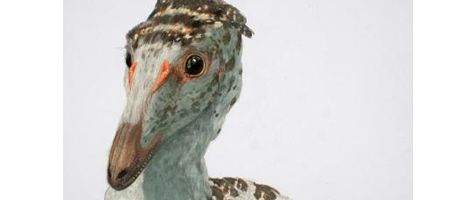Many dinosaur species were already on their way out before the asteroid strike that’s believed to have led to their mass extinction.

In general, says a German/American team of scientists, large-bodied, bulk-feeding herbivores were on the decline for the last 12 million years of the Cretaceous, which ended about 65.5 million years ago. Carnivorous dinosaurs and mid-sized herbivores, though, seemed fine.
“Few issues in the history of paleontology have fueled as much research and popular fascination as the extinction of non-avian dinosaurs,” says Steve Brusatte, a Columbia University graduate student affiliated with the American Museum of Natural History’s Division of Paleontology.
“Did sudden volcanic eruptions or an asteroid impact strike down dinosaurs during their prime? We found that it was probably much more complex than that, and maybe not the sudden catastrophe that is often portrayed.”
The research team took a new approach to dinosaur extinction, based on morphological disparity – the variability of body structure within particular groups of dinosaurs.
This, they say, gives a more accurate picture, as it’s very difficult to accurately estimate changes in the number of dinosaur species over time.
“By looking just at trends in taxonomic diversity, you get conflicting answers about the state of dinosaurs prior to extinction,” says Brusatte.
“This is because the results can be biased by uneven sampling of the fossil record. In places where more rock and fossils were formed, like in America’s Great Plains, you’ll find more species. We wanted to go beyond a simple species count for this study.”
Looking at changes in biodiversity, though, gives scientists a better picture of the dinosaurs’ overall well-being. Groups that show an increase in variability might have been evolving into more species, giving them an ecological edge, while decreasing variability could be a sign that a species is set for extinction in the long term.
The researchers calculated morphological disparity for seven major dinosaur groups covering nearly 150 different species.
They found that hadrosaurs and ceratopsids, two groups of large-bodied, bulk-feeding herbivores, may have experienced a decline in biodiversity in the 12 million years before the dinosaurs ultimately went extinct.
In contrast, small herbivores such as ankylosaurs and pachycephalosaurs, carnivorous dinosaurs like tyrannosaurs and coelurosaurs and enormous sauropods remained relatively stable or even slightly increased in biodiversity.
“These disparity calculations paint a more nuanced picture of the final 12 million years of dinosaur history,” says Brusatte.
“Contrary to how things are often perceived, the Late Cretaceous wasn’t a static ‘lost world’ that was violently interrupted by an asteroid impact. Some dinosaurs were undergoing dramatic changes during this time, and the large herbivores seem to have been mired in a long-term decline, at least in North America.”






